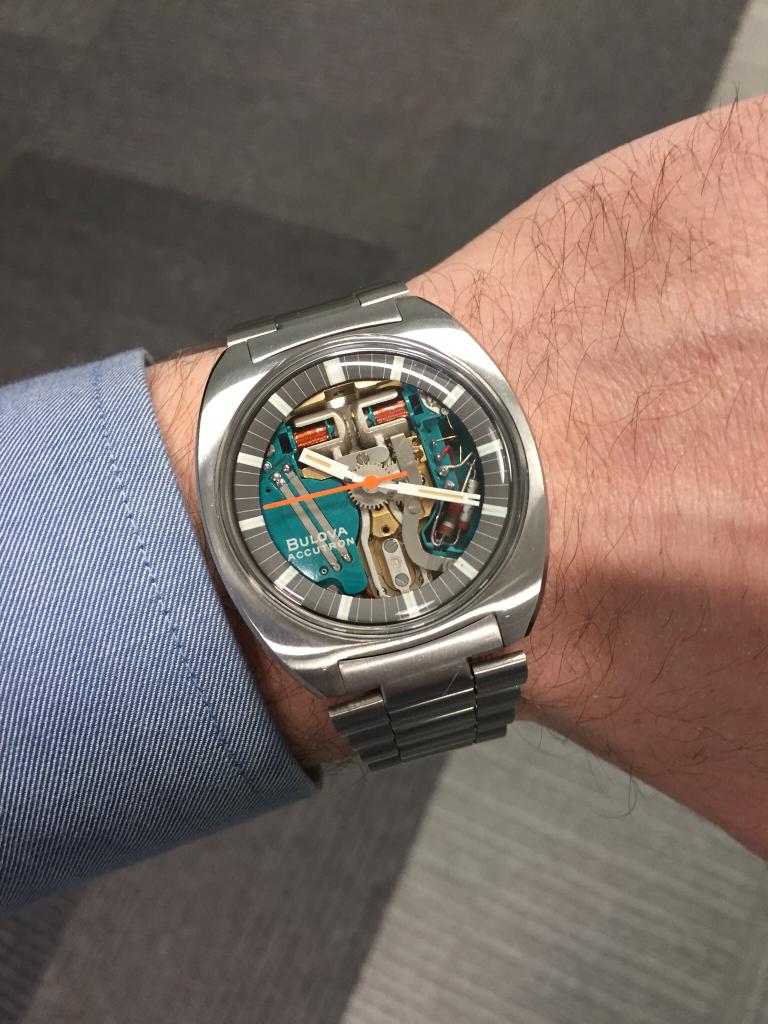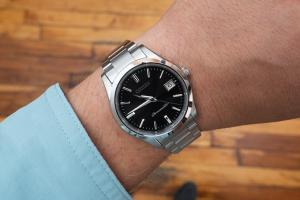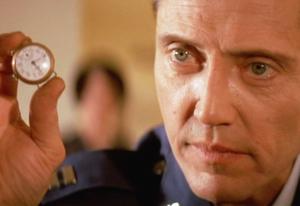Bulova Accutron: More Than Just a Timepiece

Let’s get this straight once and for all: Bulova Accutron revolutionised the watch industry for good measure. When the Accutron emerged back in the 1960s, it literally shook the landscape of horology. While everyone else opted for the traditional timekeeping methods and technology, Bulova innovated and created their own style. After years and years of determined research and development, the Accutron proves, to this day, as one of the smartest timepieces there is.
Accutron, a portmanteau of the words “accuracy” and “electronic”, used a tuning fork to provide greater accuracy in an electronic watch. Engineer Max Hetzel first devised this innovation and his models remained an iconic timepiece up to this day. The watch boasts a whole lot of firsts, most notably companioning Neil Armstrong and Buzz Aldrin during the Apollo 11 Space Mission.
To learn more about the timepiece, let’s run down its rich history and unravel what makes it such a powerful mechanism.
Brief History of Bulova
Joseph Bulova, a 23-year-old Czech immigrant, opened a modest shop on Maiden Lane, Manhattan in New York City. The shop merely sold jewellery but later grew famous for the sterling quality of their products. This led the company to open its first manufacturing arm in Bienne in 1912 — mainly focusing on mass production of watches. Back then, watches were not mass-produced. Instead, they were made in small batches or made to order.
By 1919, Bulova launched its first complete line of men’s watches. The American public greatly recognised the watches for the brand’s superb advertising efforts. However, on top of that, Bulova proved that style, precision, and technology can co-exist in one powerful mechanism.
To precisely determine the universal time, Bulova set up an observatory on the roof of a skyscraper at 580 5th Avenue (New York City) in 1927. This gave rise to greater improvements in the accuracy of the company’s products.
In no time, Bulova became an innovation giant with a bunch of firsts to mark its rich history. For instance, in 1928, the company launched the first-ever clock radio. Prior to that, the company successfully became the first brand to air a radio advertisement in 1923. The slogan “At the tone, it’s eight o’clock, Bulova Watch Time” became imperative in the company’s growth. It cemented the company’s reputation and positive publicity among its consumers. And yes, the company also produced the world’s first television advertisement in 1941.
Birth of Electronic Watches
Despite what many people believe, Bulova isn’t the first company to produce the first electronic watch. Back in 1957, Hamilton introduced the Ventura collection through a press conference in New York. That would be three years prior to the release of the Accutron. Moreover, the Ventura established its status as an icon when Elvis Presley wore it in Blue Hawaii, a film released in 1961.
Nonetheless, Bulova deserves a fair share of recognition with the invention of Accutron. The Accutron boasts itself as the first-ever electronic watch regulated by a transistor. This technology isn’t new to the industry as well but was never used for wristwatches. A century back, in 1856, Louis François Clément Breguet (grandson of Abraham-Louis Breguet, inventor of Tourbillon) patented an electric clock controlled by a 100 Hz tuning fork.
While the Accutron was launched in the 1960s, its history traces a decade back when Max Hetzel joined the company in Biel, Switzerland as an engineer.

Research and Development of the Bulova Accutron
It all began in March of 1952 when the Elgin Watch Company introduced a prototype of an electric watch. For the past 450 years, the watch industry had not seen such an innovation. Nedless to say, everyone looked forward to this an remarkable advancement.
This launch pushed Arde Bulova, then-president of the Bulova Watch Company, to assign Max Hetzel to research the new tech. Arde Bulova was worried that it could potentially threaten the company’s market share. The urge to produce a battery-powered watch tested the company’s exceptional R&D.
It didn’t take a month for Hetzel to present his findings and observation of the watch. His report stated that Elgin’s electric watch used a conventional balance wheel movement. Therefore, it couldn’t be an indication of improved accuracy. Upon further research, Hetzel hypothesised that adding a contemporary transistor could compete against the movement and become the future of electronic watches.
The Tuning Fork Success
Hetzel decided to replace the traditional balance wheel with a tuning fork. He used the first low voltage transistors, the Raytheon CK722, and the tuning fork as a frequency filter to construct his first simple tuning fork oscillator on a piece of wood. It produced a frequency of 200 Hz that ran on a 1.5 V dry cell. In 1953, Hetzel registered a patent under number 312290. It became operational in 1954. After that, Hetzel didn’t stop and produced seven other prototypes. By 1959, William O. Bennett helped develop the Calibre 214, the first tuning fork movement.
It resulted in an electronic watch with a guaranteed accuracy of 2 seconds per day or 1 minute a month — the Accutron. The Bulova Accutron heralded great accuracy by utilizing a tuning fork in between two transistors that beats at 360 times per second. Compared to the 2 Hz of mechanical watches, this feat proves fascinating. Because it oscillates a hundred times per second, the Accutron gave not only a more accurate reading but also a certain degree of shock resistance.

The New Sound of Accuracy
The Accutron ushered such a powerful innovation for great reasons. Unlike mechanical watches, the Accutron’s second hand moved smoothly. Mechanical second hands usually visibly jump a few times per second relative to the beat of the balance wheel. The Accutron, on the other hand, has the tuning fork to thank for its smooth movement. Another noticeable difference would be the sound the watch makes. While mechanical watches tick (as all traditional clocks do), the Accutron hums. The 360 Hz vibration of the tuning fork produced a very mildly audible hum.
Launch and Success of the Bulova Accutron
Bulova’s president at the time, Omar Nelson Bradly (also a retired US Army 5-Star General), introduced the Accutron on October 10, 1960. In 1961, the company started selling the Accutron Spaceview. This timepiece didn’t feature any dial to showcase the tuning fork innovation and its details. In an advertisement, Bulova boasted the watch’s 99.9977% precision.
With numerous models and versions released with the name Accutron, the timepiece easily found its status as a revered icon. It was well-regarded not only for its technology but also for its design. Bulova headlined with its intelligent construction as well as charismatic advertisements.
Bulova Accutron on the Moon
We’ve all heard the story of how the Omega Speedmaster ended up in the wrists of both Neil Armstrong and Buzz Aldrin during the Apollo 11 Space Mission. The Speedmaster on Aldrin’s wrist at the time became popular as the first-ever timepiece on the moon. However, people tend to overlook the timing instrument that remains at the moon to this day: an Accutron.
Bulova worked with NASA during the late 1950s for Project Vanguard. This project aimed to launch an artificial satellite to the Earth’s orbit using a Vanguard rocket. This partnership went on and soon enough, the Bulova Accutron timing mechanism powered the dashboard clocks of 46 US space program missions — one of which is the Apollo 11 Space Mission. As you are reading this article right now, an Accutron timing mechanism still sits in the lunar vehicle the Apollo 11 astronauts left in the Sea of Tranquility back in 1969.

Accutron and Pop Culture
Elvis Presley undoubtedly reigned the music industry. By the 1960s, the ‘King of Rock and Roll’ was the most famous man in the world. The icon, known not only for his music but also for his vast collection of timepieces, also wore the Accutron. He was often photographed with various versions and models of the Accutron — of which the most popular is a gold-case asymmetrical Accutron. He also gave an Accutron Spaceview to a fan. To this day, the timepiece can be bought in auctions.
In more recent references, AMC’s hit TV series Mad Men featured the Accutron in the very beginning of its 7th season. The season started with a hum similar to that of what the tuning fork produces. Freddy Rumsen (Joel Murray), a copywriter, shuffles through papers before looking straight into the camera and recites what appears to be a pitch for an Accutron ad.
The Quartz Effect
Like any other western brand, the birth of Quartz watches in 1969 definitely took a swing at Bulova’s tuning fork tech. It caused the Accutron to hide behind the then-trend of Quartz movements. In an attempt to go with the trend, in 1976, Bulova released an Accutron collection with quartz movements. But after about only a year, the production of Accutron watches halted after a total of 5 million pieces sold. Bulova decided to stop releasing new Accutron models. However, in 2010, they released a 50th Anniversary limited edition Spaceview watches. All the watches sold out at pre-selling. And in 2020, Bulova released another line of two new Accutron watches named Spaceview 2020 and Spaceview DNA.
Best Bulova Accutron Watch Models
With its lush history, the Bulova Accutron boasts a number of exemplary models under its name. Let’s break down all the greatest Accutron models that changed the history of time itself.

Bulova Accutron Spaceview
Perhaps the most illustrious of all, the Bulova Accutron Spaceview goes on to be the most iconic model from the line yet. At a time when Bulova boasts its timepieces as a one-of-a-kind timekeeping machine, the Spaceview accidentally becomes its supernova. Not only does this timepiece reflect the space-set goals of the time, but its design ultimately became a well-loved figure during that era. How it was an accident remains to be quite a story to tell.
At the time of the Accutron’s launch, Bulova sent model watches to dealers with the tuning fork movement on display. This was, of course, the selling point of all Accutron watches. And a point, Bulova surely made. The public grew to recognise such a curious timepiece displayed on shop windows. Salesmen willingly sold the model watches on display despite them not being official models of the Accutron. The buzz around the watch grew massive and later, Bulova was flocked with requests to create a timepiece without a dial. At the time, shops opted to remove the dials themselves just to meet the public’s incessant demands. Soon after, Bulova launched the Spaceview we know to this day.
The original Spaceview was launched with the Calibre 214 movement and later improved to the Calibre 218 movement. This timepiece also doesn’t have any crown so any adjustment must be done through the caseback.
A re-distribution of the model launched in 2010 was limited to only 1,000 editions. The timepiece possessed the same look and tuning fork movement as the 1960s model. This watch was released in commemoration of the watch’s 50th anniversary.

Bulova Accutron Astronaut
The Bulova Accutron Astronaut is a timepiece with a rotating bezel for a second timezone. Specifically made for the jet setters, Bulova later strapped the wrist of pilots who fly fast planes such as the A-12 and X-15 hypersonic rocket planes. However, the Astronaut shares almost the same fate as the Spaceview. This timepiece was never meant to be used for high-speed planes in high temperatures. But the CIA was running out of options of what timepiece to use while flying the A-12. The particular plane flew so fast that the pressure change inside the aircraft greatly affected whatever timepiece the pilots were using. However, during a test run, the Bulova Accutron Astronaut withstood that very pressure. CIA then equipped each A-12 pilot with this stellar timepiece.
The Astronaut proved unique with a 24-hour hand instead of a 12-hour hand as well as a 24-hour bezel. It too doesn’t have a conventional crown. Instead, it possessed a recessed on the caseback.
Accutron II, The Precisionist
Bulova introduced the Accutron II in BaselWorld 2014. This vintage revival took great inspiration from the original design. It also doesn’t have a dial but the tuning fork calibre 214 was released by an in-house quartz Precisionist movement. This movement boasts a precision that’s about six times over the usual quartz calibre.

Buying a Vintage Bulova Accutron
It’s quite easy to spot a fake Accutron. This is because there were more than 5 million models of the watch sold so there’s no rarity of it. Also due to this, the price of the Bulova Accutron remains humble at less than $2,000. To this day, people can still buy a Bulova Accutron. If you’re about to purchase a Bulova Accutron online, it’s best to ask a trusted source to inspect its features.
More Than Just A Timepiece — It’s a Conversation Piece
As the opening scene on the 7th season of Mad Men goes: “The Bulova Accutron is not just like any other timepiece, it’s a conversation piece”. This line still proves true even in today’s modern era. To possess an Accutron in this time and age can and should be considered a gift. Its rich history completely changed horology at its core. Its success also proves that uniqueness does work not only as a selling point but also as a technical advantage. Bulova may have discontinued the tuning fork movement, but it surely left a mark recognized by enthusiasts and collectors up to this day. It goes without saying that the Bulova Accutron effectively reinvented time and how it works.
Bulova surely knows how to make a controversial piece. Learn more about the Bulova Moon Watch and the Computron.


